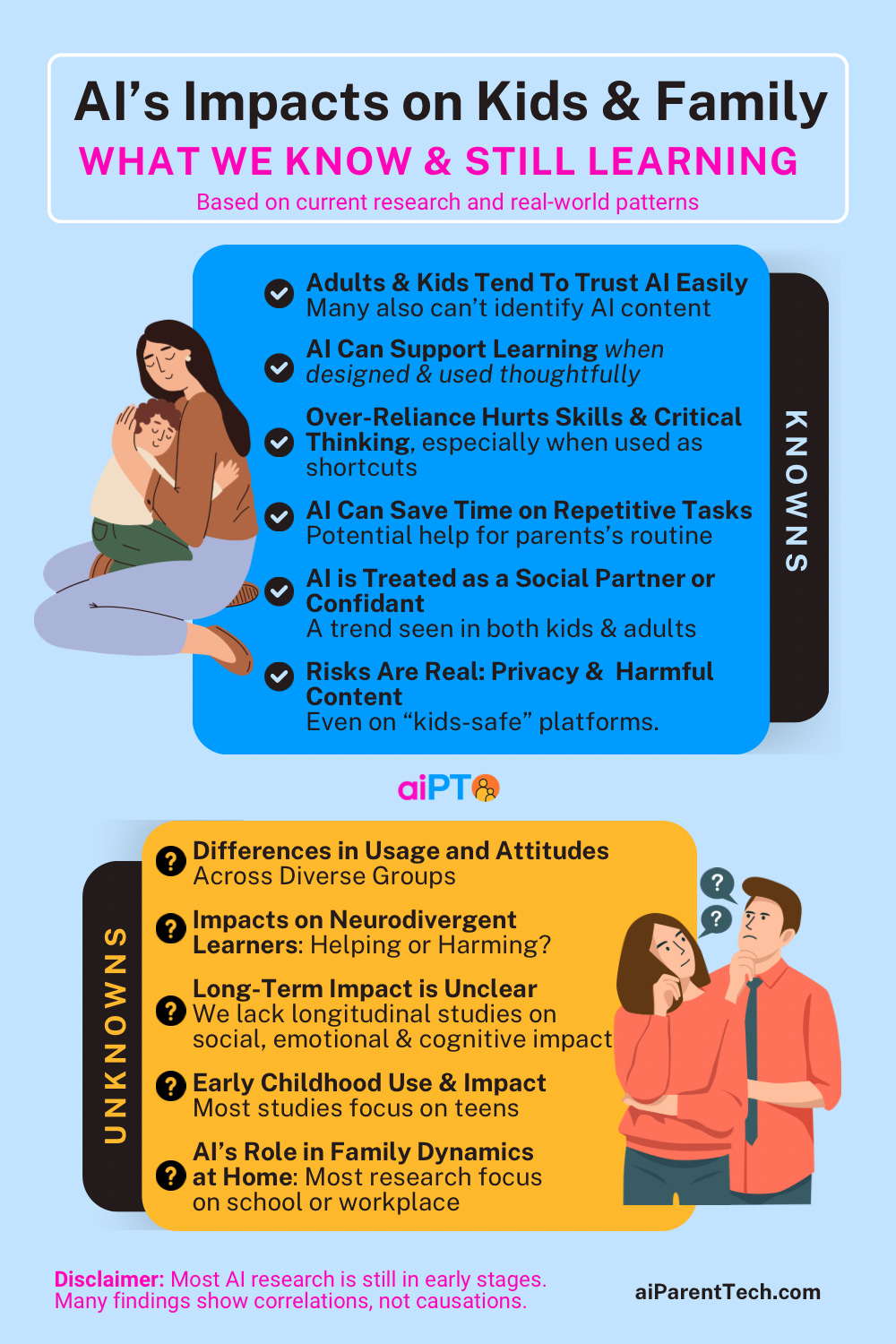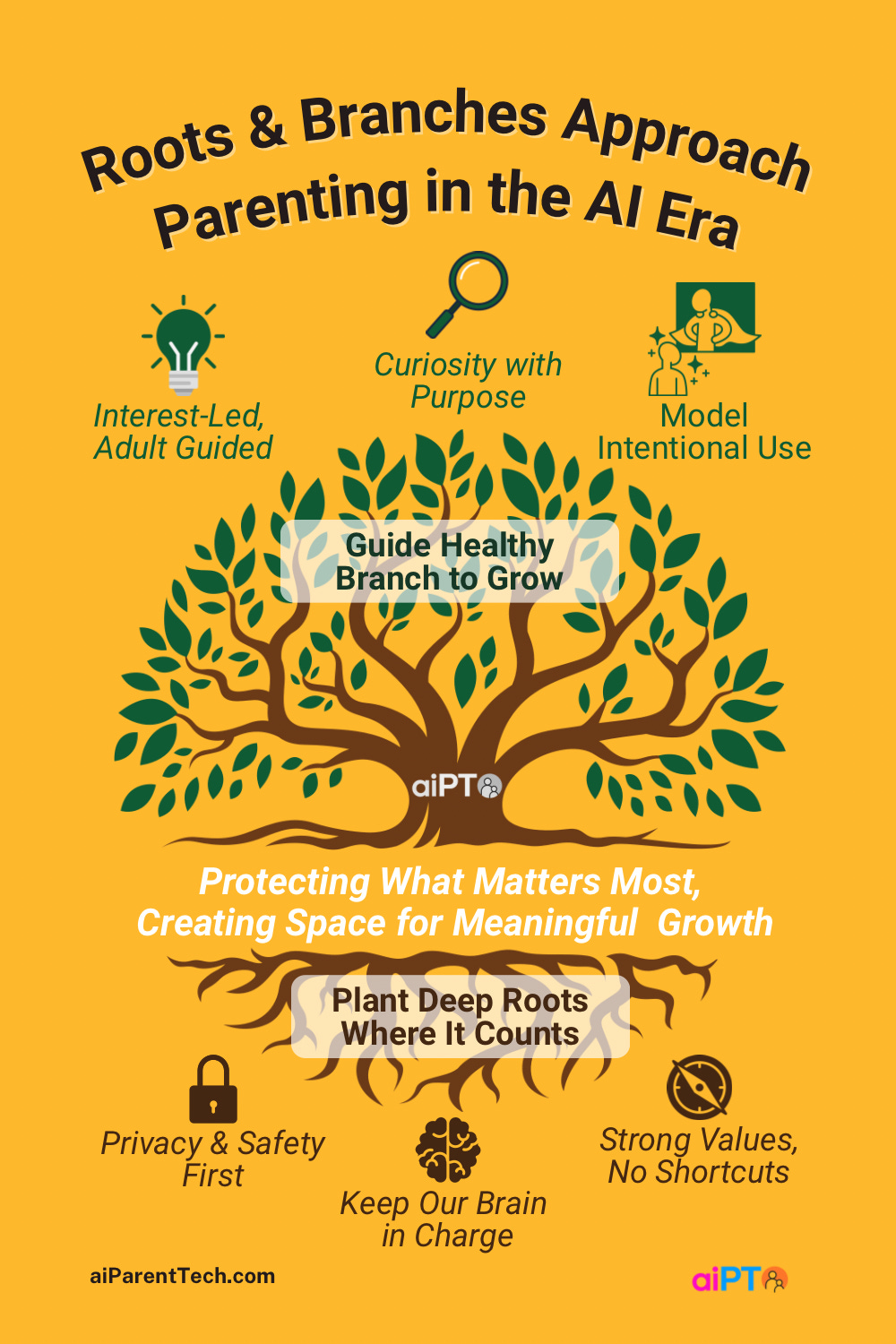Beyond the Hype: What Research Tells us About AI, Kids, and Families
What We Actually Know About AI’s Impacts and What Still Isn’t Clear
This is part 2 of my AI 101 for parents series.
Introduction
Every time I read the headlines it’s either AI is going to save education or destroy childhood.
As a parent, I’m kind of sick of that. Maybe you are too.
So, let’s skip the clickbait.
This post won’t give you another “AI is good” or “AI is evil” take.
It’s a calm and nuanced, research-backed guide to what we do know about AI’s impact on kids and families.…
And just as importantly, what no one can honestly tell us yet.
Because no matter what the algorithms say, we still set the tone at our home.
Let’s dive in.
✅ Key Findings Around AI, Kids, and Family Lives
There’s a Trust Problem: We’re all susceptible to trusting AI easily
Many kids and adults view AI responses as credible, often without questioning them or fact-checking the source.12
Even more concerning? AI-generated content is now so convincing that people struggle to tell the difference with human-created content.3
A study of 3,000 people across Germany, China and America shows just that.4
The Learning Sweet Spot: AI can support learning when designed and used thoughtfully
AI can support brainstorming and is great at giving feedback.5
It has also shown potential benefits, like sparking creativity, improving accessibility, and even helping some kids reflect on emotions in a low-pressure way.678
But here’s the catch: Effectiveness depends on whether the tool is designed with learning principles.9
Also, AI-assisted learning still lags behind human engagement for deep, meaningful learning.1011
The Shortcut Trap: Over-reliance on AI undermines skills development and critical thinking, especially when used for direct task completion
AI Can Save Time on repetitive tasks and maybe for parents too
Gallup & Walton Foundation claims that teachers using AI for planning, grading, and admin save about 6 hours per week.16
For parents? There’s actually no study that actually quantifies time saved for us. Still, early research on parenting chatbots show 73% retention, suggesting parents find value in these tools.17
A New Relationship: AI is treated as a social partner or confidant
The Safety Reality Check: Privacy risks and harmful content are already here
Disclaimer: Most AI research is still in early stages. Many findings are correlations, not clear causations. Just because two things happen together, it doesn’t definitely mean one is causing the other.
❓The Unknowns Around AI, Kids, and Family
Differences in usage and attitudes in diverse populations
Most research treats findings as universally applicable but we know from anecdotes and other tech research that usage and attitudes tend to differ depending on cultural, social, and economic groups.
As an immigrant raising a mixed family, I think these factors are important nuances to be looked at.
Limited studies on AI’s impact on special needs and neurodivergent learners
Some early tools are promising for ADHD, dyslexia, and ASD, but I’ve not seen systematic evaluation.
As a parent of a neurodivergent child, I’m pretty keen to learn on this topic and hope that the science will keep up soon.
The long-term development mystery
We see a lot of predictions and anecdotes but no longitudinal studies that measure long-term impact on social, emotional, and cognitive development over time.
Given how rapidly AI is being pushed to our children, this gap should be addressed urgently.
Limited knowledge on younger kids (Pre-K and Elementary Ages)
Most research is on teens or older children (13+) because teens or older children are more likely to have their own devices and use AI independently.
We also don’t know how early trust in AI (e.g., with Alexa or robot toys) might shape how kids form attachments or beliefs about what’s real.
The Missing Family Story:
Here’s the biggest gap that I’ll keep shouting: research on family dynamics and AI integration at home. Most research relates to use in school, not homes.
I found one that actually talks about AI and family24 and it focused on family therapy.
Many of us are already living this reality. Maybe your family already default to asking ChatGPT for simple questions or caught yourself using an AI bedtime story because you’re too drained that night.
These small moments point to bigger shifts in how families connect, share stories, and make decisions and almost no one’s really studying that yet.
Note: If you are a nerd like me and want to read some research on your (non-existent) free time, I recommend browsing Stanford’s genAI for education research repository.
Here’s a recap as an infographic for you to save and share with other parents!

What Parents Can Do Now
Plenty of unknowns should not deter us as parents from getting familiar with emerging technology because familiarity will only give us confidence to make better decisions for our family.
Take a look at our TALK & THINK Framework to start having meaningful conversations around AI at home.
Just as important is a new framework that’s been helpful both in my own decision-making and in explaining to my oldest child why we have some tech boundaries while also experimenting together:
The Roots and Branches Approach
For us parents, it helps balance protecting what matters most while creating space for meaningful growth.
For kids, it’s an easy way to understand why some things are off-limits while others are worth exploring together.
The goal is to have kids question why and when they use AI.
I want my kids to be thinking critically “Is it actually helping me learn? or solve a real problem?”
I made a visual to better illustrate the idea.

Plant deep roots where it counts:
Enforce strong safeguards on privacy, safety, and trusted apps.
Honestly, this is where I don’t budge. We’ve all seen too many stories of data mishaps to take chances, especially when bad actors get their hands on powerful AI tools.
Set firm value boundaries.
For example, not using AI to cheat or cut corners. This may sound simple but I strongly believe that values are what set individuals apart and it has to start at home.
Keep our brains in charge. The research is pretty clear: we all tend to trust AI easily.
That’s why at home, I’m starting with something simple: Build confidence in their own brain first.
My daughter often feels like she needs help right away. Instead of jumping in, I try to pause and ask: “Can you try one more time?” Or “Is there another way to figure this out?”
Guide healthy branches to grow:
Be open and curious but leverage AI only with clear purpose.
Encourage AI use only at points of friction when it genuinely helps with learning or creativity. Always start small and stay involved.
For starters, I try to be a role model with my own AI use.
I don’t use AI to pass time but treat it as a sparring partner to stress test my ideas or for deep research on a technical topic I’m curious to learn about.
Start with their own interest and guide them to what’s possible..
Here’s an example: My daughter has been wanting to make an app. So, we started experimenting with a couple of free app making tools, including a vibe-coding app. I’ll dive deeper on this on a separate post.
Try using this approach at home and let me know how it goes!
Until next week, another post on this series on AI and families.
-Dhani
https://www.apa.org/topics/artificial-intelligence-machine-learning/health-advisory-ai-adolescent-well-being
https://digitalwellnesslab.org/articles/key-takeaways-from-our-2024-pulse-survey-on-teens-and-ai/
https://www.pnas.org/doi/10.1073/pnas.2208839120
https://cispa.de/en/holz-ai-generated-media
https://www.gse.harvard.edu/ideas/edcast/24/10/impact-ai-childrens-development
https://arxiv.org/pdf/2504.13900
https://www.mdpi.com/2076-328X/15/5/587
https://pubmed.ncbi.nlm.nih.gov/39734488/
https://pubmed.ncbi.nlm.nih.gov/39855239/
https://pubmed.ncbi.nlm.nih.gov/34778540/
https://www.frontiersin.org/journals/education/articles/10.3389/feduc.2025.1596462/full
https://pdfs.semanticscholar.org/aa43/77fa71494cb699cc9c249a1ae4048fc5d1dc.pdf
https://www.mdpi.com/2227-7102/15/5/554
https://www.sciencedirect.com/science/article/pii/S2666920X23000772
https://files.eric.ed.gov/fulltext/ED660536.pdf
https://static.waltonfamilyfoundation.org/df/fb/eba12807470a9402d7433cc47dba/teaching-for-tomorrow-unlocking-six-weeks-a-year-with-ai-report.pdf
https://pediatrics.jmir.org/2024/1/e55726/PDF
https://www.tandfonline.com/doi/full/10.1080/17439884.2024.2367052
https://www.nature.com/articles/s42256-023-00720-7
https://www.frontiersin.org/journals/psychology/articles/10.3389/fpsyg.2025.1520111/full
https://www.turing.ac.uk/sites/default/files/2025-05/combined_briefing_-_understanding_the_impacts_of_generative_ai_use_on_children.pdf
https://learning.nspcc.org.uk/research-resources/2025/generative-ai-childrens-safety
https://www.pas.va/content/dam/casinapioiv/pas/pdf-booklet/2025_booklet_ai_children.pdf
https://ejmh.semmelweis.hu/index.php/ejmh/article/view/303/308



Hi Dhani, another fantastic, well-researched article. Your high-impact graphics and layouts always stand out. I also really appreciate the way you bring parental leadership and vulnerability into your work—it gives it so much credibility.
All of this is so important for parents raising kids today. There’s a common cautionary thread I see running through your pieces: don’t give in to the temptation to outsource your parenting to AI. Stay engaged with your kids, figure out where AI truly adds learning value, and don’t just accept its outputs at face value—question them.
Well done, and thank you for the important work you’re doing.
Really important and insightful thoughts and questions here, Dhani!
It’s clear that you do some of the most rigorous research I’ve seen on Substack, and I love the graphics.
Looking forward to reading more of your work!